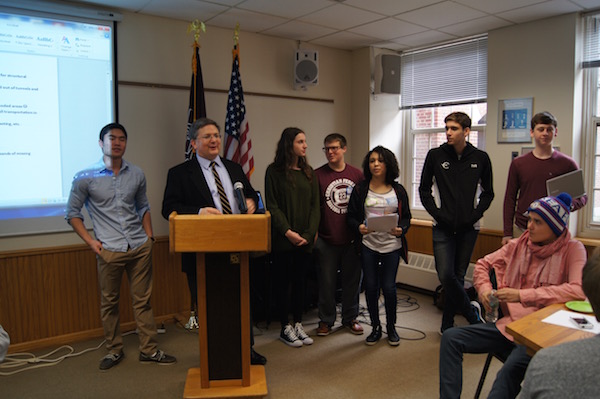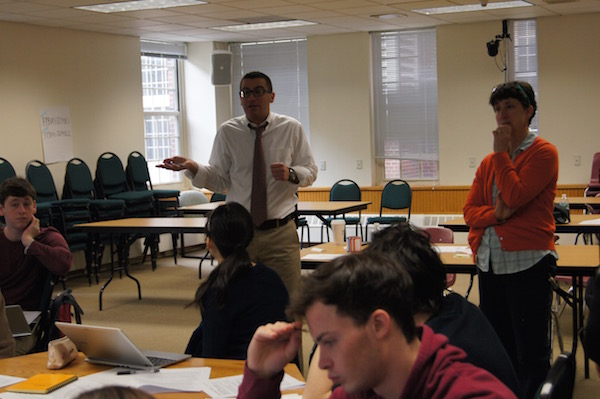SMS Students Confront Hurricane Godzilla in Emergency Response Exercise
- Thursday, 17 March 2016 10:51
- Last Updated: Thursday, 17 March 2016 15:53
- Published: Thursday, 17 March 2016 10:51
- Joanne Wallenstein
- Hits: 4166
 How do emergency management teams react to a Category 3 storm? What do they do before the storm to prepare and how do they respond once a storm has hit?
How do emergency management teams react to a Category 3 storm? What do they do before the storm to prepare and how do they respond once a storm has hit?
That's what students in Maggie Favretti and Fallon Plunkett's City 2.0 class at SHS explored as they confronted Hurricane Godzilla in a 4-hour storm simulation as a part of a public policy class focusing on urban issues and community-based design and problem solving.
At Storm Headquarters in the Board of Education Rooms at SHS on the morning of March 15, students divided into agencies to confront the rain, 120 mile per hour winds and a 20 foot storm surge that were bearing down on the city. They began by researching how each agency prepares in the 48 hours before a storm and formulated an action plan for the coming event. Here are must a few of the factors that were considered:
- Evacuation and shelter
- Transportation infrastructure including subways, streets, bridges and tunnels
- Water, sewage and sanitation
- Freight transport by sea, rail, air and trucking
- Power and energy including electricity, natural gas and steam
- Communications, phone lines, wireless networks, emergency networks and mail
During each portion of the three-hour simulation, each operations group prepared two-minute briefings for Unified Command. They outlined their priorities, protocols, obstacles and opportunities for coordination with other agencies.
There were two live press conference  with SHS History Department head John Harrison posing as the Mayor. In an adept imitation of Mayor de Blasio, Harrison explained that the storm had passed, taking at least 85 lives and causing vast property damage. Thousands of people were in shelters, the Red Cross was providing food and water and there was concern about the spread of disease. Con Edison was working to restore power and there was no subway service.
with SHS History Department head John Harrison posing as the Mayor. In an adept imitation of Mayor de Blasio, Harrison explained that the storm had passed, taking at least 85 lives and causing vast property damage. Thousands of people were in shelters, the Red Cross was providing food and water and there was concern about the spread of disease. Con Edison was working to restore power and there was no subway service.
Noah Goldberg from the Westchester County Office of Emergency Management told the teams that it could sometimes take up to eleven days to restore power and communications. He advised the teams to prepare to shelter people for weeks and to expect sanitary issues and structural problems. Bridges and tunnels might be washed away, looting could be an issue and storm debris would need to be cleared.
Also on hand to assist the students with their simulation were Gerry Stoughton, who has retired from the Port Authority and Ira Tannenbaum, from the NYC Office of Emergency Management. Two officials from the Coast Guard also helped to formulate the event but were not present: Mark Sennick and Bill Grossman were both involved in a real-life emergency. They were called away to assist in the lifting of a sunken tugboat from the Hudson River where three crewmembers died.
Stoughton told one group, "Communication is essential to any crisis. Most people do not realize how complicated the process of emergency management is since it is crucial to make sure that every agency is aware of the situation and on the same page."
The students were released from their regular  morning classes to allow them to
morning classes to allow them to
experience a real "table-top exercise." According to Maggie Favretti, "These exercises are indispensable to the Office of Emergency Management and the US Coast Guard in order to facilitate community awareness, as well as teaching the skills and habits of mind we would like our young citizens to carry with them out of high school."










